Nature provides immense emotional, spiritual and health benefits to residents of cities. There is little wonder then as to why many of us in the urban planning and design fields see nature as central and essential to all that we do and to imagining the future of cities.
The concept of biophilia is at the core and argues that we have co-evolved with nature, and that we have a deep need to affiliate with the natural world. The human species has “grown up with nature,” as Harvard biologist E.O. Wilson has said. To Wilson, biophilia is understood as “the innately emotional affiliation of human beings to other living organisms. Innate means hereditary and hence part of ultimate human nature.” It is thus not surprising that we are happier, more productive, more creative, and even more generous in the presence of nature. Nature in cities offers the promise of lives that are wondrous and connected, lives attentive to the natural magic around us.
Much of our work here at the University of Virginia has focused on connecting the urban and the natural and envisioning cities that contain bountiful and abundant nature and are committed to restoring and celebrating that nature, and to cultivating an urban ethos and populace that is profoundly connected to and cares about the nature around them—essentially what we have been calling Biophilic Cities (see Beatley, 2011).
From October 17-20, 2013, we convened an impressive group of urban leaders from around the country and the world here in Charlottesville at what we called our Biophilic Cities Launch. The conference was a significant step forward for our work developing the concepts of biophilic cities and biophilic urbanism, and extending and applying these concepts around the world. It was a culminating event, celebrating two years of collaborative research and work, but also a Launch event looking into the future of taking on the task of imagining and designing a larger network of cities and interested individuals and groups around the world willing to embrace and move forward the idea of biophilic cities.
The Biophilic Cities Project, underway for several years at the University of Virginia, stems from the essential premise that nature is absolutely essential to urban life. Biophilic cities must provide opportunities for daily contact with nature and deep connections to the natural world for citizens to be happy, healthy, and productive and to lead meaningful lives. Funding for the initial two-year research and for the conference and launch events was provided by the Washington DC-based Summit Foundation, in addition to the George Mitchell Foundation.
It was a most stimulating four days, attended by at least three fellow TNOC blog writers (Mike Houck, Lena Chan, and Cecilia Herzog). Panelists shared a mix of presentations about the innovative work of cities, the immense challenges (political and otherwise) they face in giving nature priority in their planning and design and a host of practical and innovative ideas. There were workshops, earth walks, a biophilic cities exhibition, and many, many productive and stimulating conversations over meals, walks and breaks between sessions.
Much of the work of the Biophilic Cities Project has focused on certain cities around the US and the world. In these “partner cities,” and through collaboration and information sharing, we have been able to assemble similar GIS and data layers across the cities, and to understand the detailed programs, policies and projects advancing biophilic urbanism in these cities. We have conducted site visits to partner cities, and have also been working to document the innovative urban nature projects in these cities, and the variety of tools, techniques and planning strategies utilized in protecting and incorporating nature in these cities, and in fostering connections with the natural world. One key goal of the Launch was to allow and encourage these cities to share their stories and insights and begin to help each other to better integrate nature into their planning and management.
Our partner cities, and cities we have been actively studying, have included a wonderful mix of cities actively fostering connections to the natural world, including: San Francisco, California; Portland, Oregon; Milwaukee, Wisconsin; and Phoenix, Arizona in the US, and Singapore, Vitoria-Gasteiz, Spain; Oslo, Norway; Birmingham, United Kingdom; and Wellington, New Zealand. Representatives from Rio de Janeiro, Brazil; Perth, Western Australia; and Montréal, Canada also joined the launch event and were included in the Launch exhibition, with the hope that we will begin to include them in our work as well. Attendees came from cities all over the US and beyond, including St. Louis, Missouri; Boston, Massachusetts; Houston, Texas; Stockholm, Sweden; Washington, DC; Seattle, Washington; and elsewhere. The event was extremely well organized and managed by an incredible team of faculty, staff and students at UVA, with Julia Triman, graduate student in Urban and Environmental Planning and Carla Jones, Project Manager and Instructor leading the team.
The first two days of the Launch provided partner cities the chance to present their good work, and a rather amazing and exciting set of urban nature stories emerged. An initial panel addressed ways that universities might help in advancing biophilic cities. Jana Soderlund from Curtin University in Perth, Western Australia, discussed the innovative Green Skins initiative, spearheading the installation of green walls around the port city of Fremantle, and her preliminary research assessing their reception and impact on local residents. Jana’s work is providing significant insights about what urban residents like about green walls. Her preliminary survey results show, among other things, that respondents tend to emphasize the beauty of these walls. Craig Thomas, from Arizona State University, discussed the ASU-UVA educational collaborative that has allowed several classes of honors students to analyze Phoenix neighborhoods against the metrics and concepts of biophilic cities. Kelly Hare, from Victoria University in Wellington, NZ, one of our partner cities, described the successful “halo” initiative, helping residents of that city living in close proximity to the innovative urban park and restoration project called Zealandia (a piece of wilderness in the city, where through a mammal-proof fence, native bird species such as Kaka parrot are rebounding dramatically).
We had two rousing and stimulating keynote addresses that helped push our collective thinking in important ways. An evening lecture by Jennifer Wolch laid out a Biophilic Cities “Manifesto.” Provocative and thoughtful, Wolch challenged us to think carefully about the many different and often marginalized interests (people and animals) that must be taken into account, and the potential “collisions” she sees in the movement. We must be careful, for instance, that urban greening projects like New York City’s Highline do not result in displacement and exacerbate unequal access to nature, and we must find creative ways to take full account of all species impacted, what she referred to as an “Intersectional Transspecies Urbanism.” Proponents of biophilic cities must think more about governance issues, and about the ethics of urban consumption as is impacts global nature. [You can watch the Jennifier Wolch lecture here.]
Kellert’s talk continued some of these themes, presenting the evidence and evolutionary logic for biophilia and arguing that that biophilic values “need to be nurtured and developed through learning and experience.” A strong advocate for the power of biophilia, Kellert challenged us to work to shift our values, culture and consciousness away from domination, disconnect, and transcendence of nature, to a paradigm of design and planning that understands contact with nature as essential and” deeply rooted in human biology”. He spoke of the special importance of aesthetics and beauty as biophilic values, and connections to nature. Kellert put forth at the end a set of Biophilic Urban Propositions at the end (using his own city of New Haven as an example), that explained location, livability and future thriving based on natural features and conditions. He later signed copies of his newest book, Birthright: People and Nature in the Modern World. [You can watch the Stephen Kellert lecture here.]
Friday panels provided an array of compelling examples of urban commitments to nature and biodiversity. The first morning panel addressed urban compactness and nature. Matt Burlin of Portland, Oregon described the many impressive urban greening efforts there, including the some 1,300 green streets, examples of that city’s innovative approach to stormwater management, and he ended with video of the thousands of residents watching and reacting to the spectacle of tens of thousands of migratory Vaux’s Swifts descending down the chimney of a city school.
Rebeca Dios Lema described the history of efforts in Vitoria-Gasteiz, the capital of the Basque Country of Spain, and a recent Green Capital City of Europe, to restore nature and to establish its green ring, and more recent efforts to extend that ring into the interior of this very compact and walkable city. Finally, Lena Chan, Director of the National Biodiversity Center (and a TNOC blogger!) descried the many impressive efforts of Singapore to implement its vision of itself as a “City in a Garden.” These efforts include promoting Skyrise Greening, an innovative Park Connectors network, and support for the creation of community gardens and green schools, among many others. She also reported on Singapore’s Comprehensive Marine Biodiversity Inventory (which is about halfway completed), and Lena tells me that already they have discovered some 64 new marine species (i.e. species not known to science).
A second late morning panel “Urban Nature on the Edge” provided equally impressive stories of the efforts to conserve and enhance nature in San Francisco, California, Wellington, New Zealand, and Rio de Janeiro, Brazil. Peter Brastow, the City of San Francisco’s Senior Biodiversity Coordinator and Scott Edmondson, from the city’s planning department, together described this city’s major ongoing and emerging efforts, including a vision for connecting parks and natural areas within the city, and restoring native habitats. Several areas of innovation were discussed, including the city’s urban forest management plan, Green Connections initiative (planning and improving some 24 routes by which residents can reach nature in the city), and the city’s new Biodiversity Program. Particularly impressive are the many examples of community-based stewardship in the city. Together these efforts will allow the city to shift its vision from “Park City” to “Wild City.”
Amber Bill, who heads Wellington’s Our Living City Programme, described that city’s impressive efforts, including its town belt and green belt, and new emerging idea of a blue belt, that would encompass the harbor, marine reserve, and other marine and water environments. Finally Cecilia Herzog (another TNOC blog author!) discussed the impressive nature of Rio de Janeiro, the efforts of her NGO Inverde (for instance in the design and planning of the Olympic Green Corridor), but also the sobering difficulties faced in advancing an urban nature or urban ecology agenda in that city (with relevance certainly to other cities).
The afternoon panel saw efforts in three more cities described: Milwaukee, Wisconsin, Montréal, Canada and Birmingham, United Kingdom. Here the focus was more on how nature might be enhanced and reinvigorated in older cities. Matt Howard, Environmental Sustainability Director for the City of Milwaukee, described many initiatives there, including continuing efforts to restore the city’s rivers with new efforts focused on the Menomonee River (and an impressive new Urban Ecology Center and park opened there). Montréal has recently completed its first biodiversity action plan, which Sabine Courcier described, along with other urban greening innovations there, including the city Green Alleys program. Finally, Nick Grayson described Birmingham’s innovative planning efforts connecting a number of public health concerns (air pollution, urban heat, poverty) with a vision of how the city’s natural assets (e.g. its network of small streams) might be harnessed to address them and to reduce overall chronic stress.
A key goal of the conference and launch was to provide opportunities for partner cities to share insights about work and experience, and to begin to develop personal and institutional relationships that will lead to future sharing and collaboration. That seems to be very much what happened, with attendees sharing stories and ideas over the course of the event, and forming friendships and developing plans for future interactions and collaborations.
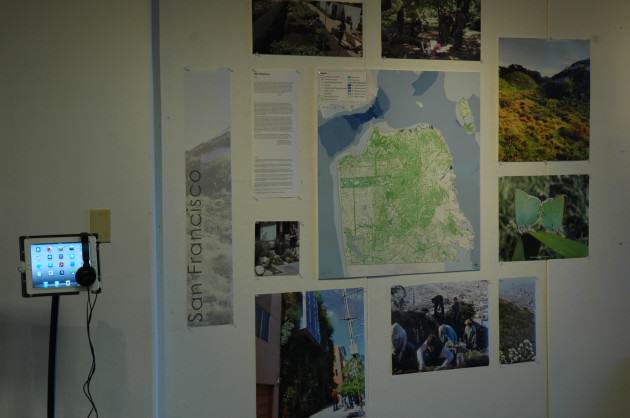
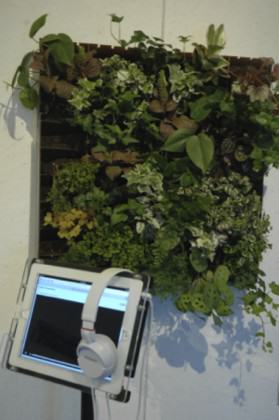 In addition to the main city presentations on Thursday and Friday, there were a number of side events, earth walks, and workshops for participants and the general public. These includes walking tours of the Dell Stream Day-lighting project on the UVA Grounds and the Meadow Creek Stream Restoration Project (in the City of Charlottesville, a collaboration of the city and The Nature Conservancy).
In addition to the main city presentations on Thursday and Friday, there were a number of side events, earth walks, and workshops for participants and the general public. These includes walking tours of the Dell Stream Day-lighting project on the UVA Grounds and the Meadow Creek Stream Restoration Project (in the City of Charlottesville, a collaboration of the city and The Nature Conservancy).
On the first day of the conference a workshop on green walls was jointly organized and run by Jana Soderlund, from Western Australia, and two graduate student members of the UVA Biophilic Cities team: Mariah Gleason and Amanda Beck. The graduate students, as part of the Launch and exhibition, built a clever, rollable green wall, from wood palettes (see below). They explained this design and have prepared how-to instructions for others interested in building a similar structure, which can be found here. Jana discussed in more detailed her efforts in Fremantle, and at the end, Launch participants joined together to plant several additional (commercial) mountable green walls, which once planted became part of the biophilic cities exhibition.
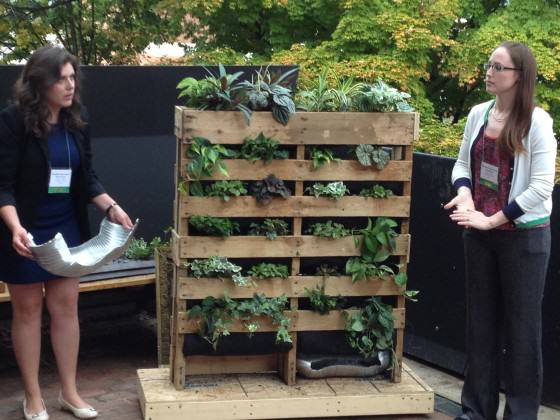 One of my favorite events had to do with ants. We were joined for most of the launch by an entomology post-doc from North Carolina State University, Amy Savage. On Friday, during the bulk of our presentations from partner cities, Amy was busy setting out ant bait (including such things as Snickers bars, tuna, and pecan Sandies), attempting to see just how many species of ants she might find in and around the UVA School of Architecture. She was quite successful and discovered 13 different species in short order, in close proximity to where we were meeting. Education about this ant diversity, the habitat we were sharing that day, became something we attempted to weave into the more formal meeting and power point presentations. With Amy’s help at several points during the day we interrupted the Launch presentations with a report on what species had been found. We also produced a series of five ant collecting cards, with images of ant genus on one side and information about biophilic cities on the other side.
One of my favorite events had to do with ants. We were joined for most of the launch by an entomology post-doc from North Carolina State University, Amy Savage. On Friday, during the bulk of our presentations from partner cities, Amy was busy setting out ant bait (including such things as Snickers bars, tuna, and pecan Sandies), attempting to see just how many species of ants she might find in and around the UVA School of Architecture. She was quite successful and discovered 13 different species in short order, in close proximity to where we were meeting. Education about this ant diversity, the habitat we were sharing that day, became something we attempted to weave into the more formal meeting and power point presentations. With Amy’s help at several points during the day we interrupted the Launch presentations with a report on what species had been found. We also produced a series of five ant collecting cards, with images of ant genus on one side and information about biophilic cities on the other side.
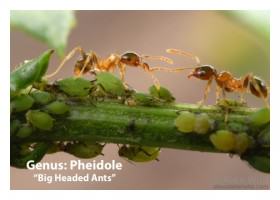 The incorporation of ants provided a visceral demonstration on the ways in which nature, much of it small and difficult to see, is all around us in cities. There is immense wonder and fascination value in ants, of course, yet urbanites are not well educated in looking for, identifying or even visualizing their existence all around us. Amy works with a wonderful initiative called the School of Ants that seeks to engage citizens in the collection and identification of ants throughout the country. They have produced a highly valuable urban ant identification guide, copies of which were distributed during the Launch.
The incorporation of ants provided a visceral demonstration on the ways in which nature, much of it small and difficult to see, is all around us in cities. There is immense wonder and fascination value in ants, of course, yet urbanites are not well educated in looking for, identifying or even visualizing their existence all around us. Amy works with a wonderful initiative called the School of Ants that seeks to engage citizens in the collection and identification of ants throughout the country. They have produced a highly valuable urban ant identification guide, copies of which were distributed during the Launch.
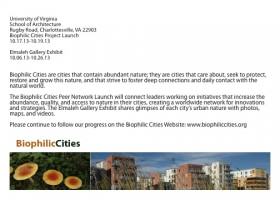 On Saturday afternoon, Amy took the ant station, including her microscope, to the Charlottesville Downtown Mall, engaging children and families walking by about the ants around them—something we called the Urban Ant Safari! In her interactions with people on the downtown mall Amy asked people to write down memories and recollections they had about ants in their past. She later compiled and shared these with us, and some were quite moving. An older woman wrote a note about her days as a child in England during WWII. She wrote, ‘When I was an evacuated little girl of 5 in WWII Britain, I used to watch ants. I dreamed of having a see through container, so that I [could] watch them work.’
On Saturday afternoon, Amy took the ant station, including her microscope, to the Charlottesville Downtown Mall, engaging children and families walking by about the ants around them—something we called the Urban Ant Safari! In her interactions with people on the downtown mall Amy asked people to write down memories and recollections they had about ants in their past. She later compiled and shared these with us, and some were quite moving. An older woman wrote a note about her days as a child in England during WWII. She wrote, ‘When I was an evacuated little girl of 5 in WWII Britain, I used to watch ants. I dreamed of having a see through container, so that I [could] watch them work.’
On Saturday evening, John Hadidian, Senior Wildlife Scientist with the Humane Society of the United States, presented ideas for human-wildlife coexistence in cities, passionately arguing for tolerance and understanding, and offering a number of examples of approaches and strategies for co-existence and non-lethal resolution of conflicts.
On the final day of the Launch, participants traveled to Washington, DC, to paddle up the Anacostia River on canoes. Hosted by the Anacostia Watershed Society, participants saw an unusual side to that capital and the hidden nature, from abundant cormorants to sunning river water turtles.We learned about green rooftop subsidies, and other efforts to green the City of Washington and areas around the Anacostia River.
One major premise of the Project has been the power of telling stories about nature in cities through still images and film. In pursuit of the latter goal, several short documentary films have been prepared about our study cities, with several premiered at the Launch event. Indeed, Friday evening became our biophilic cities film night (which we kiddingly referred to as the first annual Biophilic Cities Film Festival). The feature film was Stephen Kellert and Jim Finegan’s beautiful hour-long documentary Biophilic Design (featuring several Launch attendees, including Bill Browning of Terrapin Green). The film presents a dizzying array of projects and sites, with a heavy emphasis on buildings of various kinds and the biophilic powers they deliver.
Four biophilic film shorts were premiered, as well, three telling the story of partner cities. These included films about Singapore, Wellington (NZ), and McDowell Desert Preserve (in the urban environs near Phoenix). A fourth short film told the story of the restoration of Meadow Creek in Charlottesville, Virginia. These are now on YouTube, and available to view:
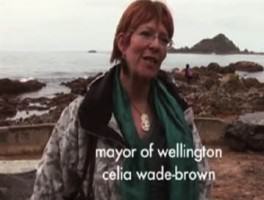 Taking place alongside the conference and launch we also organized a major Biophilic Cities Exhibition in the UVA School of Architecture’s largest exhibition space, the Elmalah Gallery. With mounted images and text about each partner city, largely provided by participant cities, and consistently formatted maps presenting the comprehensive nature in each city, the result was a spectacular picture of the many different ways in which nature can be planned and designed into urban areas. Along with still images, film and video were available on stands with mounted iPads. Two of our graduate students, Sarah Schramm and Harriett Jameson had a major hand in designing and installing the exhibition.
Taking place alongside the conference and launch we also organized a major Biophilic Cities Exhibition in the UVA School of Architecture’s largest exhibition space, the Elmalah Gallery. With mounted images and text about each partner city, largely provided by participant cities, and consistently formatted maps presenting the comprehensive nature in each city, the result was a spectacular picture of the many different ways in which nature can be planned and designed into urban areas. Along with still images, film and video were available on stands with mounted iPads. Two of our graduate students, Sarah Schramm and Harriett Jameson had a major hand in designing and installing the exhibition.
One of the most interesting features in the exhibition was a beautiful glass terrarium, which we commissioned from the design firm Crooked Nest, based in San Francisco. Our UVA team designed and built an equally beautiful biophilic table made from recycled wood and steel. The wood table top was routed to convey the pattern of a water ripple, with the terrarium placed in the center of the ripple, as if it had just fallen from above.
The terrarium quickly became known locally as the “’biophilic bubble!” It is quite arresting and soothing in the small nature it provides. A fitting piece of the exhibition, the bubble graced postcards and publications announcing the exhibition and conference and became a kind of symbol for the importance and potential of small natural elements to deliver some of the power of nature. Stephen Kellert reminded us at several points of the importance of considering the kinds of nature that might be brought into indoor and interior spaces, recognizing that more than 90 percent of our typical day is spent inside (despite efforts to get us out of doors). Planning and design of biophilic cities ought not to forget the impact and value of bringing nature inside as well, where we can.
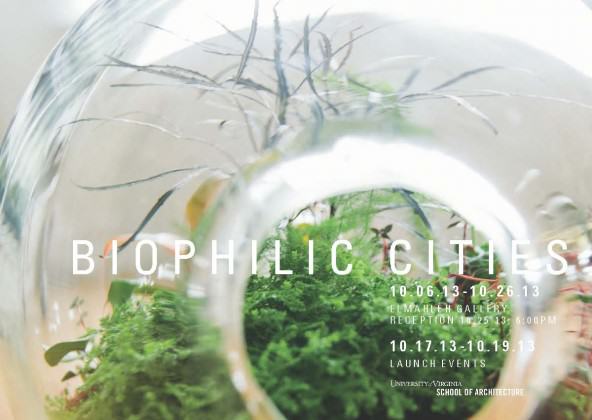
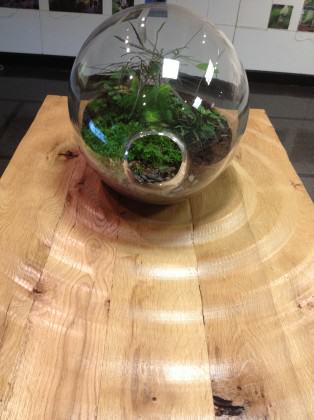 On Saturday morning a smaller group, mostly partner city representatives, came together to participate in a workshop to discuss and invent the new global Biophilic Cities Network. For several hours we discussed and debated key questions about what the Network could or should look like, what functions it will serve, what value it will have, and how and in what ways it might meet needs not served by other networks that exist.
On Saturday morning a smaller group, mostly partner city representatives, came together to participate in a workshop to discuss and invent the new global Biophilic Cities Network. For several hours we discussed and debated key questions about what the Network could or should look like, what functions it will serve, what value it will have, and how and in what ways it might meet needs not served by other networks that exist.
There was considerable enthusiasm for the network and at the end of the meeting as a symbolic gesture and show of support participants went outside and signed a blown-up version of the Biophilic Cities Pledge Card. Meant very much as a draft and work in progress, we have already revised and amended this card, but here is the card as we discussed it that day.
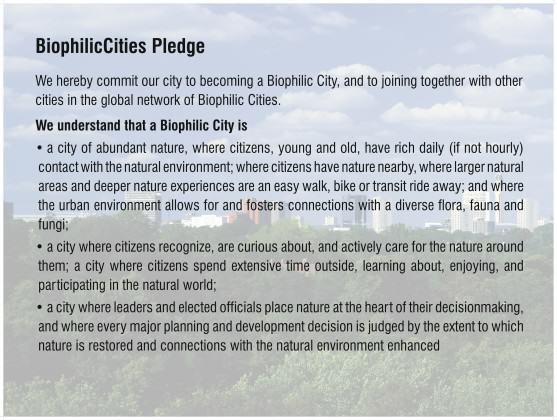
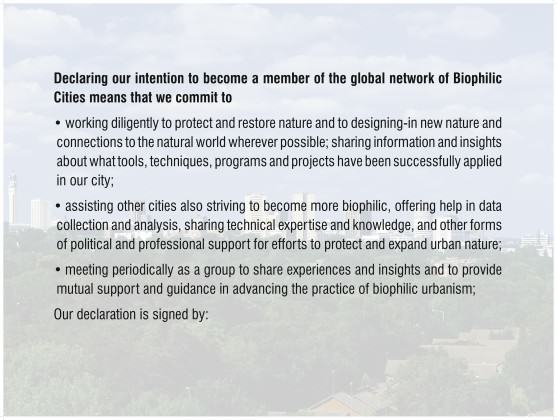
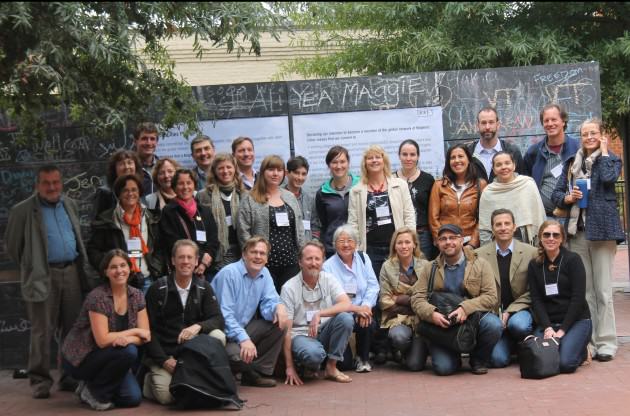 One of the most useful parts of our discussion had to do with what value of such a global network and how it would serve to strengthen the position of those in and outside city government working in support of nature. Some participants emphasized the importance of different local departments breaking out of their silos and that the network might help to do this. Others noted that the pledge card seemed to envision participants and signatories as primarily local council or local governments, but that left out universities, NGOs and many others with a stake in the network but working outside the city government.
One of the most useful parts of our discussion had to do with what value of such a global network and how it would serve to strengthen the position of those in and outside city government working in support of nature. Some participants emphasized the importance of different local departments breaking out of their silos and that the network might help to do this. Others noted that the pledge card seemed to envision participants and signatories as primarily local council or local governments, but that left out universities, NGOs and many others with a stake in the network but working outside the city government.
One of the most interesting ideas is that the network might serve as a focal or organizing point for nature across a city and across the sectors of that city. This is something that had not occurred to me that in addition to the global network linking cities in different places and regions it might also serve to link disparate interests and actors within a city (and then perhaps linking these local constellations across the globe!).
There is still much to be done, as we near completion of our two-year Summit grant and look to the rolling-out of the global network. Key deliverables for the project will include a case book of best urban practices, including analyses of the accomplishments and urban-nature innovations in each city. We are also developing an urban-nature index as an aggregate measure of connections to nature, and as a way of comparing exposure to nature across cities. Other pieces of this work we hope to complete include a Delphi study through which we hope to be able to offers insights about the minimum daily amount of nature needed in cities. And of course we will continue to maintain and expand our Biophilic Cities webpage, blog, and e-newsletters.
Please stay tuned as we determine the exact language and mechanisms through which cities can declare their intentions to be a biophilic city (some version of the pledge language above) and participate in the Network.
We hope to grow this network into a global force on behalf of nature in cities and we will need your help! If you or your city would like to join the Biophilic Cities Network, please send us an email: [email protected].
by Tim Beatley
Charlottesville

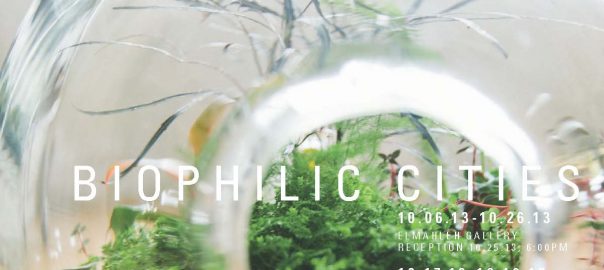


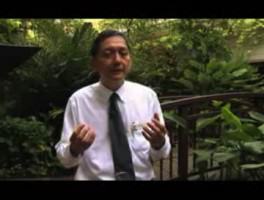





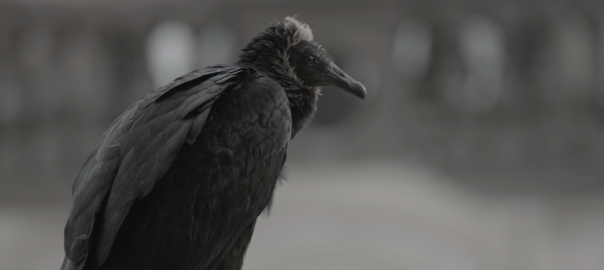
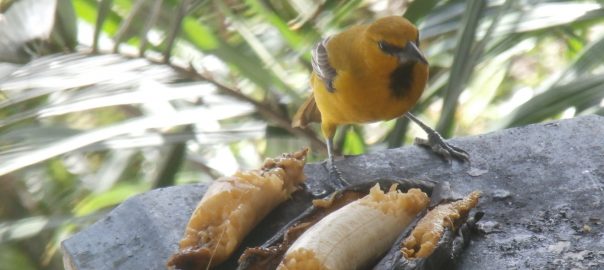
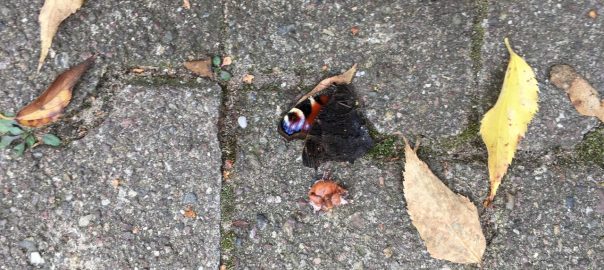
dear Professor Beatley
I’m very happy to find someone like you who is thinking about the environment. I’d love to keep going. So I chose my thesis as the presentation of the biophilic pattern in the city. I would be very happy to be in touch with you. I am a doctoral student in geography and urban planning. I am asking for help. thank you
Dear Tim
I am so happy I have found your page and work. That is exactly what I’ve been searching for all of my life. I would love to join you and cope with you. I would love to propose a work on a 5B Design Proposal which would be: BIOPHILIC DESIGN, BIOREMEDIATION, BIOPOLICY, BEAUTY AND BIOETHICAL key elements to arouse the best of our souls into cities, into towns and neighborhoods. Let me know how can I make contact by email, I am currently working in the University, as a Professor on Sustainable Project. This is who I am. I made Architecture and Urbanism and Post Graduated on Industrial Engineering and Environmental Management, now it time to raise up my voice and arms to work on a REAL LIFE PROJECT, WITH A VERY, VERY SPECIAL TEAM such as you are.
Thanks for the additional links, Maddox! Great supplementary material for a great article! I anticipate hearing more about all of these programs!
Tim, great post and great meeting, the short while I was able to join you from my other event in Chapel Hill. We are looking forward to your keynote address here in Portland at the Twelfth Annual Urban Ecology and Conservation Symposium at which David Maddox keynoted last year. A great opportunity to keep the Biophilic Cities and Nature of Cities dialogue going in The Intertwine (www.theintertwine.org) region and city of Portland. For those reading these blogs if you want to know more about the Urban Ecosystem Research Research Consortium and the annual Urban Ecology and Conservation Symposium, held at Portland State University, February 10, 2014, go to: http://www.uercportland.org/
Tim, see you in February! Maddox, looking forward to ecosystem services conversations to come
Mike Houck, Director
Urban Greenspaces Institute
Portland OR
http://www.urbangreenspaces.org